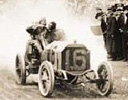33
Long Beach, Calif, April 13 — This is the 33rd running of the Long Beach Grand Prix. I suppose it's appropriate that it's my first time here because my Spec Racer Ford number is 33.
 (Photos by .)
(Photos by .)
We didn't pick 33 for the racecar for any significant reason. The selection was made for purely practical reasons. Since there are times you don't always get your number in SCCA Club Racing, you need to be able to change it. Thus, 33 can easily be turned into 38, 83, or 88.
The formation of the LBGP was also done for purely practical reasons. Chris Pook, a local travel agent, wanted to revitalize a city suffering from a slow death, whose only claim to fame was harboring the Queen Mary. Thus, his dream was to build a Monaco Grand Prix in the United States.
As most know, the first race was a Formula 5000 event because in those days, you had to prove to the FIA that a site was capable of hosting a street race before they would give you a Formula 1 event. Nowadays, all you need are the proper credentials, i.e., boatloads of money stuffed in Bernie Ecclestone's pockets.
Brian Redman won the inaugural race thanks mainly to early leaders Tony Brise, Al Unser, Sr., and Mario Andretti falling by the wayside. Redman drove a Jim Hall T-332 Boraxo Lola. He completed the 50 laps in 1:10:12.042 for an average speed of 86.325 mph around the first configuration of 2.02 miles. The podium finishers were the only other cars to complete all 50 laps with Vern Schuppan in second and Eppie Wietzes in third.
Our West Coast Photo Editor, Jeff Davidson, was at that first race watching it from his friend's apartment balcony overlooking Linden's Leap.
The following year, Long Beach got their F1 race and Clay Regazzoni embarrassed the field by running laps faster than his qualifying times en route to a 42.4 second victory over Niki Lauda and Patrick Depailler in a Ferrari. Sadly, the popular Swiss would suffer paralyzing injuries at this track four years later.
1977 was the most significant event for the LBGP because that was the year the event almost died. Creditors were all over Pook and supposedly the founder delayed wiring the prize money to the FIA before the teams made the trip to the States. As the story goes, when Ecclestone showed up for the weekend asking for the money, Pook told him he didn't have it.
Since all the teams were already here making it nearly impossible to cancel the event, Bernie allegedly responded with, "Well, we better figure out a way to get it." Pook was one of the very few people in the world who were able to not blink under the glare of Ecclestone.
Mario Andretti's victory that year (the only USGP win by an American driver not counting the U.S. Grand Prize era of 1908-16) saved the event because it brought publicity you couldn't buy. It made headlines in The New York Times, Sports Illustrated, as well as local and national news. The race became a major sporting event, and the sponsors and money began to flow in.
The city went along for the ride. The porn movie theaters and boarded up abandoned buildings gave way to office buildings, restaurants, and hotels. Though Long Beach could never become an actual Monte Carlo, it was becoming the second most famous street race in the world.
1984 was the next significant milestone for the LBGP. F1 purses, sanctioning fees, and shipping costs (the American promoters had to pay to get everyone to these shores) were going through the roof. CART approached Pook the year before, and they replaced F1 as the headline event. Many thought it was a disastrous decision.
Attendance was down the following year as fans felt some of the glamour and flair was lost. However, Mario Andretti once again won and saved the event. The headlines returned, and the LBGP as well as the fans never looked back.
The Champ Car Atlantic series also has a long history at Long Beach, running their first race as an F1 support event in 1978. Howdy Holmes won that event with Bobby Rahal getting the pole. The Atlantic series ran for five years before taking a six year break from a LBGP appearance, returning in 1989. Ever since, the series has run there.
There was a scare in 2004 when CART went to bankruptcy court but OWRS bought the assets, saving Champ Car and the LBGP in the process. Just like Long Beach, now a thriving center of international trade, tourism, and technology, was revitalized by a crazy dream by Chris Pook, the event may be able to return the favor, helping to revitalize a series saved by a crazy dream by Kevin Kalkhoven, Gerald Forsythe, and Paul Gentilozzi.
Tomorrow, I'll talk about my impressions of my first visit to the Long Beach Grand Prix.
Copyright © 2007 by Russell Jaslow and Deep Throttle. All Rights Reserved.
| 



